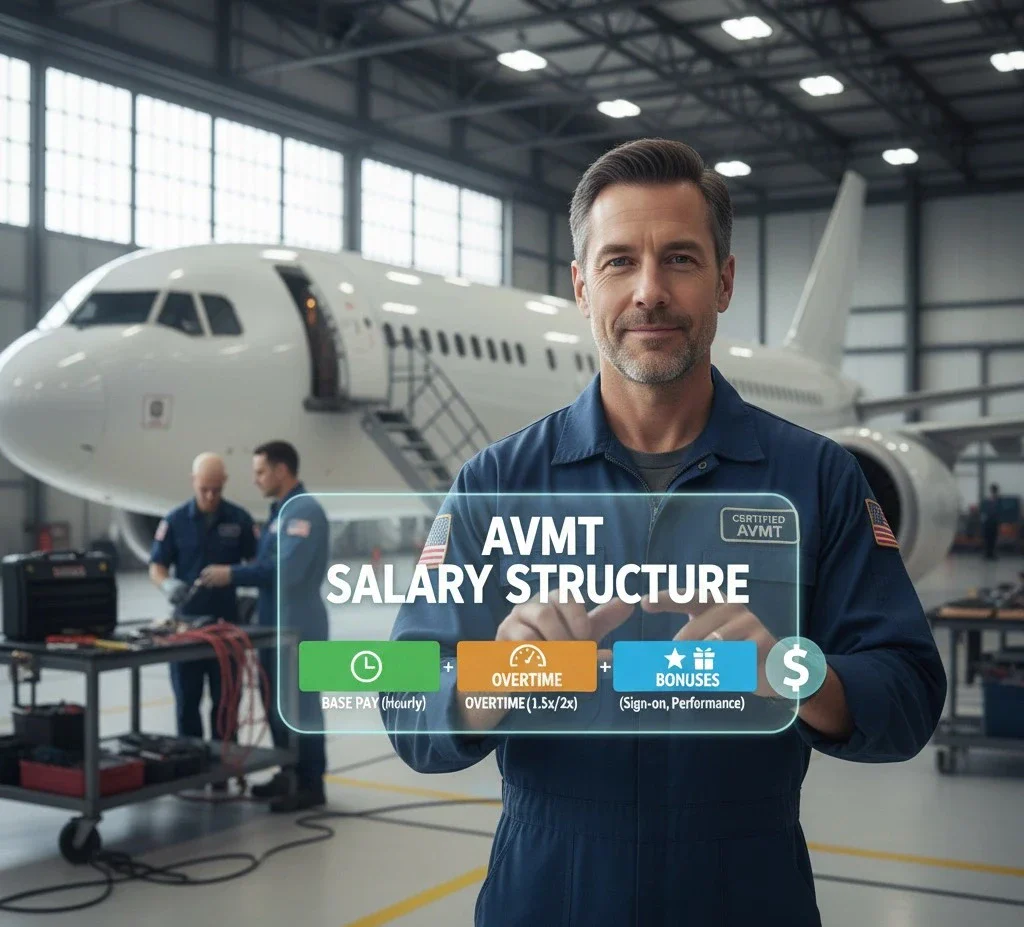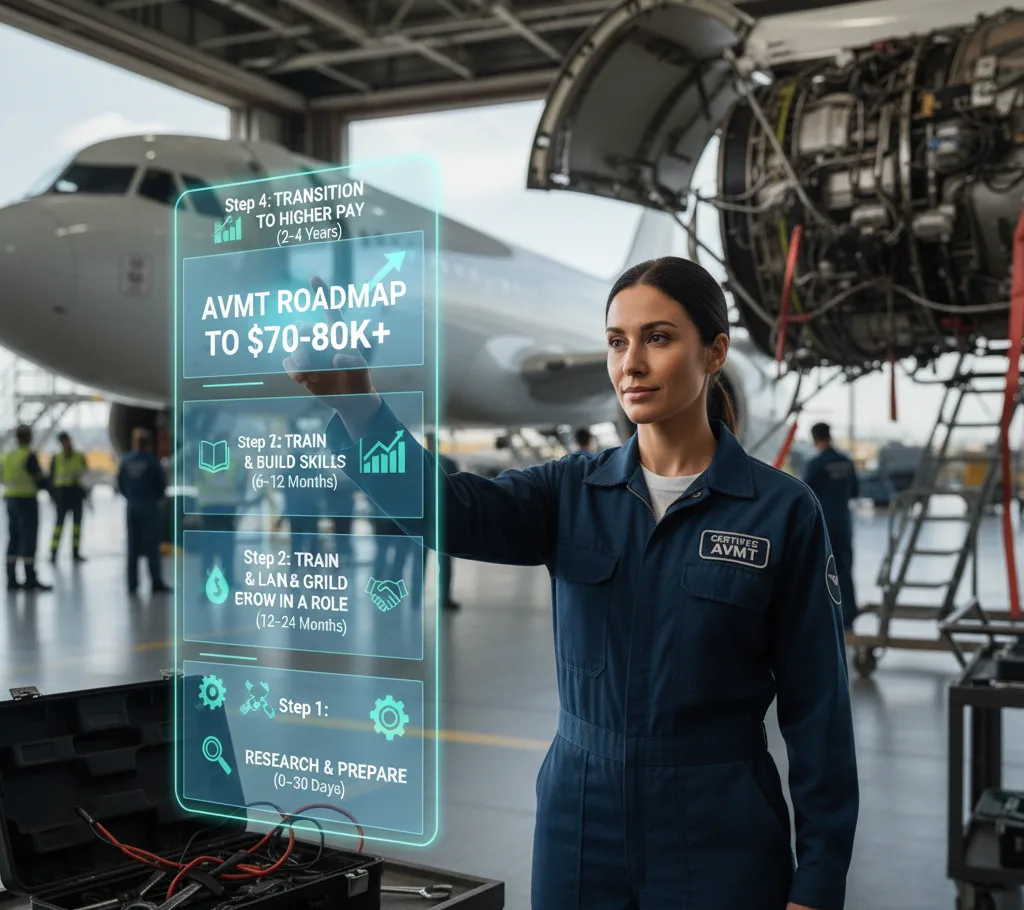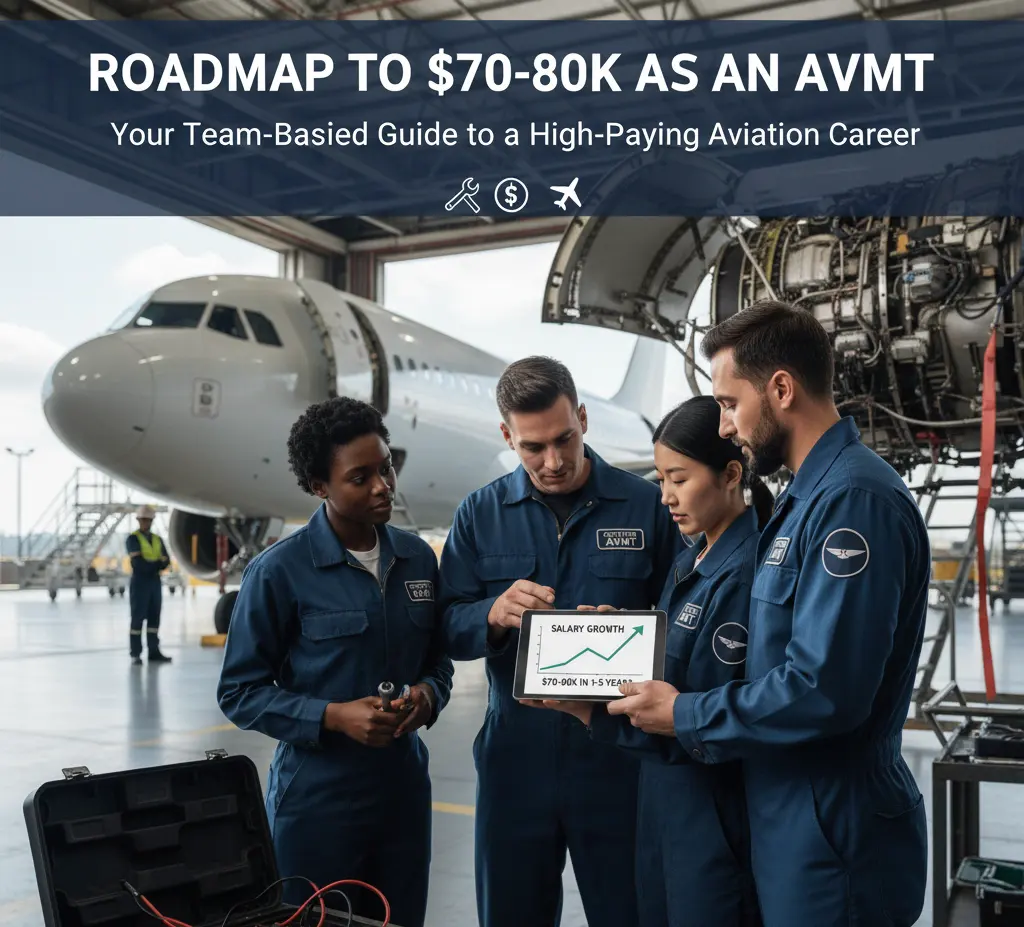Becoming an Aviation Maintenance Technician (AVMT), also known as an Airframe and Powerplant (A&P) mechanic or Aircraft Maintenance Technician (AMT), is a rewarding career with strong earning potential. If you’re wondering, “How long does it take to make $70–80K as an AVMT?” the answer depends on your training, experience, employer, and strategic career moves. This comprehensive guide outlines realistic timelines (1–5 years), salary structures, and a clear roadmap to help you achieve this income goal. Whether you’re starting from scratch, transitioning from military service, or already working as a junior technician, this article provides the insights and tools you need to succeed.
Quick Answer: How Long to Earn $70–80K as an AVMT?
For most AVMTs, reaching a $70,000–$80,000 annual salary takes 1 to 5 years, depending on several factors:
- Fast-Track Path (1–2 years): Achievable for those with prior experience (e.g., military aviation maintenance), specialized skills (e.g., avionics or turbine engines), or high-paying roles at major airlines or Maintenance, Repair, and Overhaul (MRO) facilities with significant overtime.
- Typical Path (2–4 years): Complete training, gain entry-level experience, and transition to higher-paying roles with moderate overtime.
- Conservative Path (4+ years): Slower progression in lower-paying environments, such as small Fixed Base Operators (FBOs), with limited overtime or specialization.
Key Factors Influencing Your Timeline
- Overtime and Shift Premiums: These can significantly boost your income.
- Employer Type: Airlines and MROs typically pay more than general aviation (GA) shops.
- Geographic Location: High-cost-of-living states or aviation hubs often offer higher wages.
- Certifications and Specialization: Skills like avionics or Inspection Authorization (IA) command premium pay.
- Negotiation and Reputation: Strong negotiation and a solid work record accelerate earnings.
Your path to $70–80K will depend on how you leverage these factors. Let’s dive into the details.
Understanding the AVMT Role and Salary Potential
What Is an AVMT?
An Aviation Maintenance Technician (AVMT) maintains and repairs aircraft to ensure safety and airworthiness. The most common U.S. credential is the FAA Airframe and Powerplant (A&P) certification, often referred to interchangeably with AVMT or AMT. Employers typically seek A&P-certified technicians, though some roles require additional specializations.
Common Job Titles and Roles
- A&P Mechanic: Handles airframe and powerplant maintenance, the core of most AVMT roles.
- Avionics Technician: Focuses on aircraft electronics, such as navigation and communication systems.
- Inspection Authorization (IA): Allows technicians to sign off on inspections, increasing responsibility and pay.
- Lead/Senior Technician or Shop Supervisor: Leadership roles with higher salaries.
Each role has distinct responsibilities and pay scales, with specialized or leadership positions offering greater earning potential.
Why Specialization Matters
Specialized skills, such as avionics, turbine engine repair, or composites, can significantly increase your salary. Leadership roles or Inspection Authorization (IA) credentials also command a premium, as they require advanced expertise and responsibility.
How AVMT Salaries Are Structured

How AVMT Salaries Are Structured
Base Pay, Overtime, and Bonuses
Most AVMTs earn an hourly wage, with total annual income calculated as:
(Base hourly rate × regular hours × 52 weeks) + (Overtime rate × overtime hours × 52 weeks) + Shift premiums + Bonuses
- Overtime: Typically paid at 1.5x or 2x the base rate, often available during peak seasons or night shifts.
- Shift Premiums: Extra pay for night, weekend, or holiday shifts.
- Bonuses: May include sign-on bonuses, performance incentives, or relocation assistance.
For example, a technician earning $35/hour with 40 regular hours per week earns $72,800 annually. Adding 10 hours of weekly overtime at 1.5x ($52.50/hour) can add $27,300, pushing total income to $100,100.
Salary Benchmarks
According to the U.S. Bureau of Labor Statistics (BLS, May 2024):
- Median wage for aircraft mechanics and service technicians: $78,680.
- Median wage for avionics technicians: $81,390.
- Top 10% (90th percentile): Over $100,000 annually.
Job platforms like Indeed report base hourly rates of $30–$35+ for AVMTs, with variations by region and employer. For instance, Epic Flight Academy notes that New Jersey offers some of the highest average wages, reaching ~$109,380 for top roles in 2024.
Industry and Geographic Variations
- Airlines and MROs: Offer structured pay scales, consistent overtime, and benefits.
- Corporate/Private Jet Operations: Pay well for specialized turbine or avionics skills.
- General Aviation (GA) and FBOs: Often lower-paying but may offer flexibility.
- High-Paying Regions: States like New Jersey, New York, Massachusetts, Nevada, and Minnesota have higher wages due to major aviation hubs or high living costs.
Training and Certification: Your Foundation
FAA A&P Certification
To work as an AVMT and progress toward $70–80K, you’ll likely need an FAA A&P certification. You can earn this through:
- FAA Part-147 School: Formal programs combining classroom and hands-on training.
- On-the-Job Training (OJT): Practical experience under a certified mechanic.
- Military Experience: Maintenance roles in the military may qualify for certification credits.
The FAA requires:
- 18 months of practical experience for a single rating (Airframe or Powerplant).
- 30 months for both ratings combined.
- Formal schooling can substitute for some or all experience requirements.
Training Program Durations
- FAA Part-147 Programs: Typically 18–24 months for both A&P ratings.
- Accelerated Programs: Some schools offer intensive courses to shorten timelines.
- OJT: Varies widely; you may start earning sooner but progress more slowly without formal training.
Costs and ROI
Training costs vary by program and region, ranging from $10,000 to $40,000. Many schools offer financial aid, scholarships, or GI Bill benefits. Schools with strong industry partnerships and job placement programs provide better ROI by helping you secure higher-paying roles faster.
Military Experience Advantage
Military veterans with aviation maintenance experience may qualify for advanced placement or waivers, allowing faster certification and job placement, often at higher starting salaries.
Realistic Timelines to Reach $70–80K
Fast-Track Path (1–2 Years)
Assumptions:
- Prior experience (e.g., military or aviation-related work).
- Enroll in an accelerated A&P program.
- Secure a high-paying role at an airline or MRO with significant overtime.
Example:
- Base Pay: $40/hour × 40 hours/week × 52 weeks = $83,200.
- Overtime: 10 hours/week at 1.5x ($60/hour) = $31,200.
- Total: ~$114,400 (before taxes).
Risks: Relies on employer demand, overtime availability, and your ability to secure a premium role quickly.
Typical Path (2–4 Years)
Assumptions:
- Complete a standard 18–24-month A&P program.
- Start in an entry-level role (e.g., GA or MRO, $45–55K).
- Transition to an airline or higher-paying MRO role by year 3–4 with moderate overtime.
Example Progression:
- Year 0: Entry-level role at $45,000.
- Year 1–2: Gain experience, earn $55–65K.
- Year 3–4: Move to airline/MRO, reach $70–80K.
Conservative Path (4+ Years)
Assumptions:
- Work in a lower-paying region or small FBO.
- Limited overtime or specialization.
How to Accelerate:
- Pursue high-demand skills (e.g., avionics, turbine engines).
- Relocate to high-paying regions or employers.
- Maximize overtime and shift premiums.
Sample Salary Progression Table
| Year | Fast-Track | Typical | Conservative |
| Year 0 | $55,000 (Military/Tech Hire) | $45,000 (Entry MRO/GA) | $40,000 (Small FBO) |
| Year 1 | $75,000+ | $55,000 | $45,000 |
| Year 2 | $90,000+ | $65,000 | $50,000 |
| Year 3 | $100,000+ | $75,000 | $55,000 |
| Year 4+ | $110,000+ | $80,000+ | $60,000+ |
Note: Actual outcomes vary based on location, employer, overtime, and individual effort.
Key Levers to Accelerate Earnings
1. Choose High-Paying Employers
- Airlines and MROs: Offer structured pay, benefits, and overtime.
- Corporate/Private Jets: Pay well for specialized skills.
- Cargo Operators: Often provide consistent overtime.
2. Specialize for Premium Pay
- Avionics: High demand for electronic systems expertise.
- Turbine Engines: Valued in corporate and airline roles.
- Inspection Authorization (IA): Boosts responsibility and pay.
- Composites: Increasingly relevant for modern aircraft.
3. Gain Experience and Leadership Roles
- Move into lead technician, inspector, or supervisory roles for pay increases.
- Build a strong reputation through safety and efficiency.
4. Optimize Location and Union Status
- High-Paying States: New Jersey, New York, Massachusetts, Nevada.
- Union vs. Nonunion: Union shops may offer better pay scales; nonunion shops may provide flexibility or bonuses.
- Cost of Living: A $75K salary stretches further in low-cost areas.
5. Maximize Overtime and Side Work
- Work night/weekend shifts for premiums.
- Take on contract or seasonal roles for extra income.
Actionable Steps to Reach $70–80K Faster

Actionable Steps to Reach $70–80K Faster
Step 1: Research and Prepare (0–30 Days)
- Explore FAA Part-147 schools with strong job placement records.
- Update your resume with relevant experience (e.g., military, mechanical skills).
- Research local employers’ pay bands and overtime policies.
Step 2: Train and Build Skills (6–12 Months)
- Enroll in an A&P program or pursue OJT.
- Start specialized coursework (e.g., avionics, turbine engines).
- Network with industry professionals via LinkedIn or aviation forums.
Step 3: Land and Grow in a Role (12–24 Months)
- Apply for entry-level roles at MROs, airlines, or corporate operators.
- Negotiate overtime and shift premiums upfront.
- Pursue additional certifications (e.g., IA) to boost value.
Step 4: Transition to Higher Pay (2–4 Years)
- Move to a major airline or MRO for better pay scales.
- Take on leadership roles or specialize further.
- Maximize overtime and explore contract work.
Salary Negotiation Strategies
Sample Dialogue for Recruiters
- “Can you share the base hourly rate and typical overtime hours for this role?”
- “Are there shift premiums for nights or weekends, and how much?”
- “Does this position offer sign-on bonuses or relocation assistance?”
Key Questions to Ask
- What’s the average weekly overtime for technicians?
- Is there a performance review or raise schedule?
- Are there opportunities for specialization training?
Framing Your Value
- Highlight quantifiable achievements: e.g., “Completed 100+ inspections with zero discrepancies.”
- Emphasize specializations: e.g., “Certified in avionics with experience on Boeing 737 systems.”
- Showcase reliability: e.g., “Maintained a 100% safety record over 2 years.”
Regional and Employer Pay Insights
Top-Paying States
- New Jersey: ~$109,380 for top roles (Epic Flight Academy, 2024).
- New York, Massachusetts, Nevada, Minnesota: High wages due to aviation hubs and cost of living.
Employer Pay Bands
- Airlines/MROs: Median wages often exceed $95,000 (BLS, 2024).
- Corporate Jets: High pay for turbine/avionics specialists.
- GA/FBOs: Lower base pay but potential flexibility.
Cost-of-Living Considerations
A $75,000 salary in a low-cost state (e.g., Texas) may offer more purchasing power than $100,000 in a high-cost metro (e.g., New York City). Use cost-of-living calculators to evaluate offers.
Beyond $80K: Long-Term Career Growth

Beyond $80K Long-Term Career Growth
Pathways to $100K+
- Senior Technician or Supervisor: Lead roles with higher pay.
- Quality Assurance (QA): Oversee maintenance compliance.
- MRO Ownership or Contracting: Start your own shop or take high-paying contract roles.
- Teaching/Technical Sales: Leverage expertise in training or sales roles.
Strategic Career Moves
- Switch to larger employers for better pay scales.
- Pursue leadership roles to increase responsibility and income.
- Invest in continuous education to stay competitive.
Common Myths and Pitfalls to Avoid
Myth 1: “A&P Certification Guarantees High Pay”
- Reality: Certification is just the start. Employer, location, and specialization drive earnings.
Myth 2: “Overtime Isn’t Necessary”
- Reality: Overtime and shift premiums are often critical to reaching $70–80K.
Myth 3: “Staying in GA Roles Is Enough”
- Reality: Small FBOs often pay less. Move to airlines or MROs for growth.
Myth 4: “Generalist Skills Are Sufficient”
- Reality: Specialization (e.g., avionics, IA) unlocks higher pay faster.
Tools and Resources
Salary Calculator Formula
Estimate your annual income with: (Base hourly rate × 40 hours × 52 weeks) + (Overtime rate × overtime hours × 52 weeks) + Bonuses
Example: $30/hour base, 10 hours/week overtime at 1.5x ($45/hour):
- Base: $30 × 40 × 52 = $62,400
- Overtime: $45 × 10 × 52 = $23,400
- Total: $85,800
Authoritative Resources
- BLS: Wage data for mechanics and avionics technicians (bls.gov).
- FAA: A&P certification requirements (faa.gov).
- Thrust Institute: Training program insights (thrustinstitute.com).
- Indeed/Glassdoor: Real-time salary data (indeed.com, glassdoor.com).
Recommended Schools
- Look for FAA Part-147 schools with avionics/turbine modules and strong job placement rates.
- Examples: Aviation Institute of Maintenance, Pittsburgh Institute of Aeronautics.
FAQ
Q: How long does it take to make $70–80K as an AVMT?
A: Typically 1–5 years, depending on experience, specialization, and employer. Fast tracks (1–2 years) are possible with military experience or high-demand roles; most take 2–4 years.
Q: Can I earn $70–80K in my first year?
A: Rare but possible with a high base rate, significant overtime, or prior experience (e.g., military).
Q: Which states pay AVMTs the most?
A: New Jersey, New York, Massachusetts, Nevada, and Minnesota, due to aviation hubs and higher living costs.
Q: Does military experience shorten the path?
A: Yes, it can count toward FAA certification and make you more attractive to employers.
Q: What specializations boost pay?
A: Avionics, turbine engines, Inspection Authorization (IA), and composites are high-demand skills.
Conclusion
Earning $70–80K as an Aviation Maintenance Technician is achievable within 1–5 years, depending on your training, employer, and career strategy. Military experience, specialized skills like avionics or turbine repair, and maximizing overtime are key to accelerating your timeline. Use the actionable steps, negotiation tips, and resources in this guide to build a clear path to your income goal. With persistence and smart choices, you can turn your AVMT career into a high-earning, fulfilling profession.

